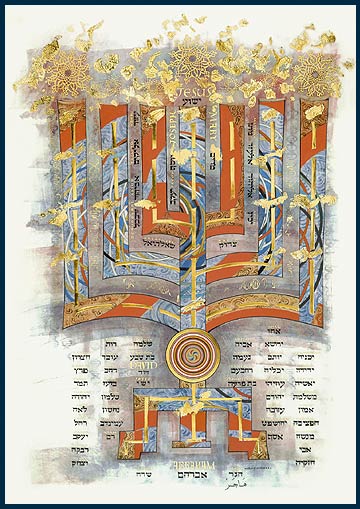

![]()
![]()

Matthew frontispiece: The Genealogy of Christ
(Matthew 1:1-17)
Donald Jackson
Natural hand-ground ink on calfskin vellum
Image copyright 2002 The Saint John's Bible and Saint John's University
The Gospel of Matthew begins with the genealogy of Christ. Reaching back into the Old Testament scriptures to Abraham, progenitor of the Hebrew nation, Matthew lists the names of succeeding generations, culminating in the birth of Christ.
This illumination is a family tree structured as both a tree of life and a menorah, the Jewish seven-branched candlestick. Placed at the beginning of the first gospel, the menorah serves as a bridge between the Old and New Testaments. A mandala-like cosmic image near the base is common to several religions and implies the universality of the search for God. The intricate gold medallions above the menorah were inspired by illuminations from the Koran. Reflecting our own time, patterns of DNA double helixes between the outer branches emphasize the connectedness of all humanity.
The ancestral names flank the base of the menorah/tree and march up between the innermost branches. Abraham's name appears in English and Hebrew, with that of his wife, Sarah, from whom these generations arose. Named in both Arabic and English is Hagar, Sarah's handmaiden, with whom Abraham fathered Ishmael, the ancestor of the Prophet Muhammad, founder of Islam. At the very top is the name of Jesus, in the same lettering style as Abraham, David, Mary, and Joseph.
Click on a page:

The Parable of the Sower and the Seed

The Genealogy of Christ




